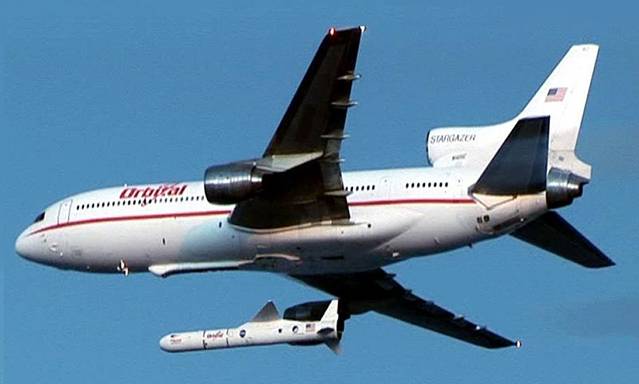PEGASUS XL FACT SHEET
By Cliff Lethbridge

Pegasus XL Launch, Photo Courtesy Orbital Sciences Corporation
Classification: Space Launch Vehicle
Date of First Cape Canaveral Launch: February 9, 1993
Date of Final Cape Canaveral Launch: Active
Number of Cape Canaveral Launches: Active
Making effective application of Air-Launched Ballistic Missile (ALBM) research conducted decades earlier by a number of aerospace contractors, Orbital Sciences Corporation succeeded in creating an air-launched space launch vehicle called Pegasus XL. Like an ALBM, the Pegasus XL rocket is dropped from an aircraft and fired seconds later. But instead of completing a ballistic trajectory to carry a weapons payload to its target like an ALBM, the Pegasus XL carries a payload into space. An Alliant Techsystems Orion 50SXL solid rocket motor serves as the Pegasus XL first stage. The first stage is 33 feet, 8 inches long and has a diameter of 4 feet, 2 inches. The first stage burns HTPB solid fuel and can produce a thrust of 163,247 pounds.
An Alliant Techsystems Orion 50XL solid rocket motor serves as the Pegasus XL second stage. The second stage is 10 feet, 2 inches long and has a diameter of 4 feet, 2 inches. The second stage burns HTPB solid fuel and can produce a thrust of 34,515 pounds.
An Alliant Techsystems Orion 38 solid rocket motor serves as the Pegasus XL third stage. The third stage is 4 feet, 5 inches long and has a diameter of 3 feet, 2 inches. The third stage burns HTPB solid fuel and can produce a thrust of 7,155 pounds. An optional fourth stage called Hydrazine Auxiliary Propulsion System (HAPS) is available for the Pegasus XL, and can provide precision orbital insertion capability for the payload. The HAPS fourth stage burns hydrazine liquid fuel. Another optional fourth stage for the Pegasus XL is the Thiokol Star 27 solid rocket motor, which burns HTPB solid fuel and can provide Earth-escape trajectory capability for the payload. The Pegasus XL employs a standard payload fairing which is 7 feet long and has a diameter of 3 feet, 8 inches. The Pegasus XL payload fairing is able to accommodate one payload in a dedicated launch configuration or two payloads in a shared launch configuration.
In a typical mission profile without a fourth stage, the Pegasus XL is dropped over open water from a customized L-1011 aircraft (early Pegasus XL rockets were dropped from B-52 aircraft) flying at an altitude of 38,000 feet. The drop is considered to be the actual launch, although the first stage is not fired until five seconds later. The first stage is fired five seconds after launch when the Pegasus XL is at an altitude of 37,640 feet. The rocket employs an inertial guidance system to pitch it upward after the first stage is ignited. The first stage burns out 77 seconds after launch, and is jettisoned. The second stage is fired 95 seconds after launch. This is followed by separation of the payload fairing at 111 seconds after launch. The second stage burns out 168 seconds after launch, at which time the second and third stage combination begin an unpowered coast period. During this coast period, the second stage remains attached to provide aerodynamic stability. Ultimately, the spent second stage is jettisoned and the third stage is fired 592 seconds after launch. The third stage burns out 657 seconds after launch and is jettisoned from the payload, having successfully inserted it into orbit. Although a variety of stage combinations and orbital insertions are available to meet specific mission requirements, the Pegasus XL is able to carry a maximum 1,000-pound payload to low-Earth orbit or a maximum 275-pound payload on an Earth-escape trajectory.


